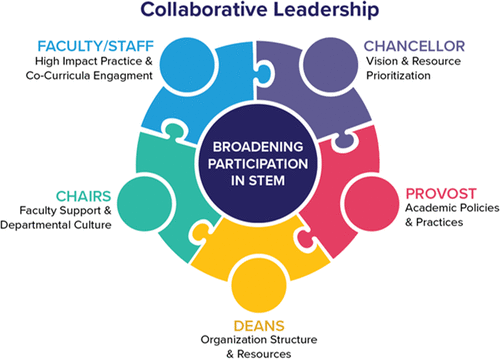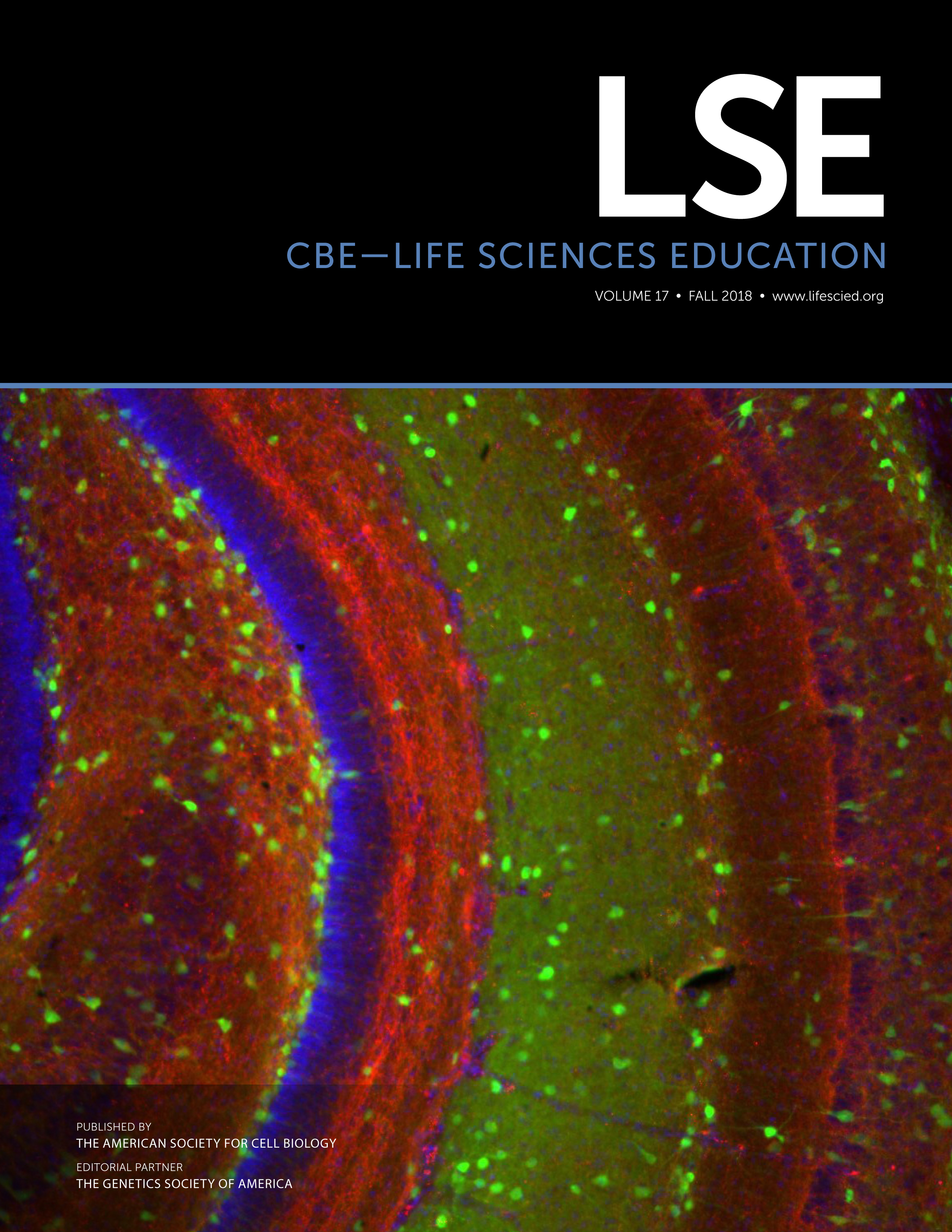Transforming STEM Education through Collaborative Leadership at Historically Black Colleges and Universities
Historically Black colleges and universities (HBCUs) currently represent ∼3% of all higher education institutions in the United States. Yet they produce nearly 25% of all African-American baccalaureates and 20% of African-American baccalaureates in science and engineering in particular (Mack et al., 2011). Further, HBCUs serve as the baccalaureate origin of nearly 25% of African-American PhD recipients in science, technology, engineering, and mathematics (STEM; Fiegener and Proudfoot, 2013). Consequently, HBCUs, including North Carolina A&T State University (NCA&T), have played and continue to play a critical role in addressing underrepresentation in STEM and in studying mechanisms related to broadening participation in these disciplines (Goins et al., 2009; Mack et al., 2011).
At NCA&T, a group of faculty members and administrators have used a collaborative leadership approach (Chrislip and Larson, 1994) to broadly adopt and scale faculty use of effective pedagogies. Collaborative leadership, initially described by Chrislip and Larson in 1994, embodies a leadership approach that places an emphasis on “bringing people together in constructive ways to create an authentic vision and develop strategies for addressing the shared concerns of the community.” This brand of shared leadership fosters ownership in solving problems and promotes ingenuity by breaking down silos between groups, particularly in higher education, which often limit the advancement of change.
Collaborative leadership includes input and contributions from all levels within the university (see Figure 1). At NCA&T, campus leadership established the vision for the university, created and sustained an infrastructure and environment that helps to advance that vision, and partnered with faculty in the conceptualization of projects and redesign of intellectual spaces for teaching and learning innovation. For example, in Fall 2010, NCA&T initiated the development of a comprehensive strategic plan to advance STEM research and education on the campus. After several months of focus groups, surveys, benchmarking, and other data-collection methods, “A&T Preeminence 2020: Embracing Our Past, Creating our Future” emerged as the university’s vision for change. The plan was designed to position NCA&T as a premier research institution of higher education with a STEM focus, while preserving the core values of learning, excellence, integrity, respect, creativity, engagement, and service that underpin its unique heritage. Central to the strategic plan was the university’s commitment to enhancing its intellectual climate and ensuring that students are integrated into stimulating, inquiry-based learning environments that promote their success.

FIGURE 1. The collaborative leadership model brings together teams of individuals from various vantage points in the university to work toward a common goal, in our case, fostering connectivity to collaborate on efforts designed to broadening participation of women and underrepresented minorities in STEM.
A group of university administrators and faculty led by the chancellor then aimed to create and sustain a conducive environment by seeking a corporate gift from the North Carolina GlaxoSmithKline (NC GSK) Foundation to create a STEM Center of Excellence for Active Learning (SCEAL). The goal of SCEAL is to transform teaching and learning at the university to attract and support the success of high-achieving students who go on to STEM careers and ultimately diversify the STEM workforce. The dean of the College of Arts and Sciences and the chairs of the Departments of Biology, Chemistry, English, Mathematics, and Physics originally led SCEAL. This leadership was particularly important, because the College of Arts and Sciences served as the core of academics and general education for the university and included disciplines of life and physical sciences, arts, humanities, and social sciences. Providing gateway instruction for all majors in the university, the College of Arts and Sciences, through SCEAL, was able to set a course for teaching innovation and reform that initiated in the sciences and expanded to other disciplines.
SCEAL offered diverse mechanisms to support faculty development and engagement in teaching reform. These included an internal grants program, created by the dean for the College of Arts and Sciences, to support collaborative projects that significantly enhance student success and/or research (the Innovation Ventures Fund); teaching symposia on active learning; a Lunch-and-Learn series; and other forums for faculty to come together to discuss what they were doing. The university also gave permission for the former dean to launch a $1 million campaign to create an endowed Student Success and Faculty Development Fund. Earnings from this “alumni and friends”–supported endowment provided scholarships to recruit and retain high-achieving students and opportunities for faculty and students to: 1) attend society conferences, 2) initiate research collaborations, and 3) write scholarly manuscripts and competitive proposals. Such strategies embodied a set of comprehensive approaches to promote faculty scholarship and collaborative partnerships that advance STEM and non-STEM student success.
Collectively, the aforementioned supports helped to cultivate an emerging cultural shift that led to an increase in faculty collaborations across disciplines to write grant proposals; publish pedagogical and research papers; and present their findings at regional, local, and national meetings. SCEAL-affiliated faculty submitted proposals totaling more than $8.6 million over a 5-year period, which more than doubled the amount of proposal submissions from the prior 5-year period. Faculty also produced a collection of publications and teaching materials in areas including active-learning methods and materials (Cousins-Cooper et al., 2015, 2016a,b; Edoh et al., 2016a,b); dissemination of active-learning approaches (Fakayode, 2014; Fakayode et al., 2014, 2016a,b; Assefa, 2015, 2016; Kanipes et al., 2016; Cousins-Cooper et al., 2017); and transforming the work within academic units (Fakayode et al., 2016b; Wilson et al., 2016; Wilson-Kennedy et al., 2016).
The cultural shift in teaching and learning at NCA&T also led to an increase in the number of redesigned courses to support active learning and piloted courses across all of the center-affiliated disciplines. The SCALE-UP (Student-Centered Active Learning Environment for Undergraduate Programs) project, originally tested in the Department of Mathematics, is now being piloted in the Department of Physics. The emporium-style model for active learning, initiated and fully implemented first by the Department of the Mathematics, has been expanded for piloting in the Department of Chemistry, supported by an National Science Foundation award (#1525673). Many of the redesigned courses were tested in the newly renovated classroom/laboratory spaces funded by the NC GSK Foundation. Since the founding of SCEAL, more than 7500 students have been impacted because of the redesigned and piloted courses in biology, chemistry, physics, and mathematics. In summary, SCEAL provided a support infrastructure that fostered multiple levels of collaboration and the integration of active-learning experiences through gateway STEM courses and resulted in significant student success outcomes. For example, a study of our implementation of the mathematics emporium instructional method has shown that college algebra students enrolled in the emporium significantly outperformed students enrolled in the traditional lecture classes based on posttest results at the end of the semester (Cousins-Cooper et al., 2017).
We believe that collaboration and a focus on faculty development are keys to lasting transformative change in STEM higher education. A culture of collaboration that extends beyond collective-impact models, focused on evidence-based student success models and pedagogies, may be particularly impactful for scaling effective strategies for broadening participation at HBCUs. It should be noted that this culture of collaboration is not unique to HBCUs; however, we believe that universities with institutional cultures that value teaching excellence have the highest potential for cultivating collaborations that can lead to transformative change. Herein, collaborative leadership engages stakeholders from their positions within the university to support a common agenda to advance broad-based change. Specifically, intentional collaborative leadership at all levels is essential to assuring the types of sustainable changes that transform classrooms and academic culture to broaden participation. This leadership style engaged and inspired faculty of all ranks to focus on innovations in teaching and learning and development and implementation of active-learning pedagogies in the classroom and fostered STEM communities of practices. We believe that this leadership is contributing to lasting, ongoing change on the NCA&T campus and can be adopted by other campuses.
ACKNOWLEDGMENTS
We acknowledge the North Carolina GlaxoSmithKline Foundation and the Office of the Chancellor, North Carolina A&T State University, for funding and support to transform STEM teaching and learning spaces; and academic leaders instrumental to the project: Drs. Abdellah Ahmidouch, Faye Spencer-Maor, Mary Smith, and Guoqing Tang; and Haley Hatfield, Creative Strategist Coordinator for Research Advancement in the LSU Office of Research and Economic Development, for creative support.



